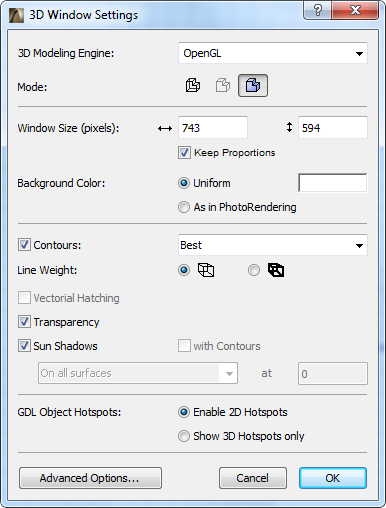
Use the View > 3D View Options > 3D Window Settings command to open this dialog box.

3D Modeling Engine: Select from the list of available 3D engines.
•OpenGL: This is the default engine and recommended if your video display card supports OpenGL. However, some effects, for example vectorial 3D hatching and the option to save the contents of the 3D window as a vectorial 2D drawing, are not available with OpenGL.
For additional options with OpenGL, click Advanced Options at the bottom of the dialog box.
See Open GL Options.
•Choose the Vectorial 3D Engine to use effects like vectorial 3D hatching and to have the option of saving the contents of the 3D window as a vectorial 2D drawing.
See also 3D Engines.
Mode: Select from model displays in 3D: Wireframe, Hidden Line (not available with OpenGL) or Shading. These modes differ in the amount of detail they show.
For more information, see 3D Engines.
Note: If you have defined a Layer as Wireframe, its elements will always appear in Wireframe mode, even if you have chosen another 3D view mode here.
Both the 3D Engines and the 3D display modes are also accessible from View > 3D View Options.
Window Size in Pixels: Enter the horizontal and vertical size of the 3D Window here.
•Keep Proportions: Check this box to always have proportions maintained.
Note: On Mac, if the 3D Window is docked, changing the size will have no effect. Undock the window before modifying these values.
Background Color: Define the background color of the 3D Window here.
•Uniform: Click this button to apply the color in the box on the right as the background color of the 3D Window. Double-click the color field to choose another color from the pop-up palette.
•As in PhotoRendering: Click this button to use the background specified in PhotoRendering Settings.
See also CineRender Basic Settings: Background Panel.
Contours: Check this box to make the contours of model elements visible in Shaded images.
•The Best option produces a perfect result, but it may be rather slow for large and complex 3D models.
•The Draft option produces a fast result, but it doesn’t eliminate all the lines that the Hidden Line method would.
Line Weight: Define lineweights for all model element edges here: either single-pixel or double-pixel lineweights/

Vectorial Hatching (not used with OpenGL Engine): Check this box to use Vectorial Hatch patterns in Hidden Line and Shaded images, provided that you have already selected a 3D Hatching in the Surfaces dialog box for any surface you are using in your Project.
For more information, see Surfaces.
Note: Vectorial 3D Hatching is also available for Section/Elevation/IE Windows and for 3D Documents, but this setting has to be made individually in each Section/Elevation/IE and 3D Document Settings dialog box. The choices made in the 3D Window Settings dialog box have no effect on Section/Elevation/IE or 3D Document windows.
Transparency: Check this box to produce transparent views of elements that have the appropriate Surfaces setting when generating a shaded view. Below, the same glass wall appears with Transparency Off and On.
When you save a view, the Transparency setting will be saved with the view.
Note: When used with the Vectorial 3D Engine, Transparency is not effective with Postscript printers.
Sun Shadows: Check this box to enable ARCHICAD’s shadow-casting capability
With the Vectorial 3D Engine, the following additional Sun Shadow controls are available:
•With Contours: show shadow contours in the 3D Window

•Use the pop-up to define where Sun Shadows are generated:
•on all surfaces, or
•on a single level only (that is, a horizontal plane). This option is useful for shadow studies in top view. If you choose this option, enter a value here to specify the absolute elevation of the horizontal plane on which the Vectorial Shadows will be generated.
GDL Object Hotspots
•Enable 2D Hotspots: Enable Hotspots defined for 2D editing. (This will give you more editing points in the 3D Window.)
•Show 3D Hotspots only
Note: If the GDL Object has no 3D hotspots at all, the 2D hotspots will be always displayed, as well as their copies projected to the zzyzx height value, provided that such a parameter has been defined for the object.